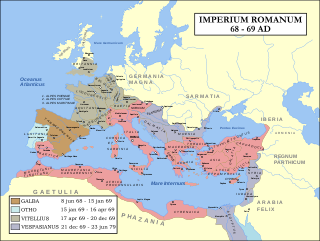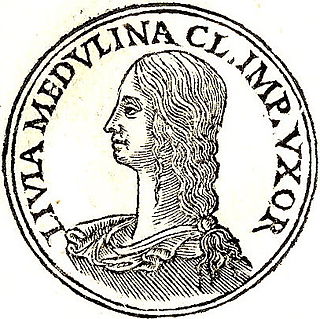AD 37 (XXXVII) was a common year starting on Tuesday of the Julian calendar. At the time, it was known as the Year of the Consulship of Proculus and Pontius. The denomination AD 37 for this year has been used since the early medieval period, when the Anno Domini calendar era became the prevalent method in Europe for naming years.

AD 69 (LXIX) was a common year starting on Sunday of the Julian calendar. At the time, it was known as the Year of the Consulship of Augustus and Rufinus. The denomination AD 69 for this year has been used since the early medieval period, when the Anno Domini calendar era became the prevalent method in Europe for naming years.

The 100s decade ran from January 1, 100, to December 31, 109.
AD 6 was a common year starting on Friday of the Julian calendar. At the time, it was known as the Year of the Consulship of Lepidus and Lucius Arruntius. The denomination "AD 6" for this year has been used since the early medieval period, when the Anno Domini calendar era became the prevalent method in Europe for naming years.

Arria was a woman in ancient Rome. Her husband, Caecina Paetus, was ordered by the emperor Claudius to commit suicide for his part in a rebellion but was not capable of forcing himself to do so. Arria wrenched the dagger from him and stabbed herself, then returned it to her husband, telling him that it didn't hurt. Her story was recorded in the letters of Pliny the Younger, who obtained his information from Arria's granddaughter, Fannia.
Lucius Arruntius was a Roman admiral. He saw action during the War with Sextus Pompeius, and the war of Mark Antony and Augustus. He is most notable for his participation during the Battle of Actium, where he was in command of victorious Augustus' central division. He was also instrumental in convincing Octavian to pardon Gaius Sosius, one of Mark Antony's generals, after his capture.

Livia Medullina Camilla was the second fiancee of the future Emperor Claudius.

Aulus Caecina Paetus was a Roman senator, who was condemned to death for his role in the revolt of Lucius Arruntius Camillus Scribonianus against the emperor Claudius. He was suffect consul in the nundinium of September to December 37 with Gaius Caninius Rebilus as his colleague.

Lucius Salvius Otho was father of the Roman emperor Otho, he was born of a distinguished and well-connected family on his mother's side. His close friendship with Tiberius, and physical similarity to him, led to rumours that he was that emperor's son.

Burnum, an archaeological site, was a Roman Legion camp and town. It is located 2.5 km north of Kistanje, in inland Dalmatia, Croatia. The remains include a praetorium, the foundations of several rooms, the amphitheatre and the aqueduct.
Marcus Furius Camillus, Senator and Consul of 8 AD, was a close friend of the emperor Tiberius.
Lucius Arruntius Camillus Scribonianus was a Roman senator, who was active during the reign of Tiberius. He was consul in AD 32. Ten years later, he revolted against the emperor Claudius, but was swiftly defeated.
The gens Arruntia was a plebeian family at Ancient Rome. Members of this gens first came to prominence during the final years of the Republic.
Lucius Arruntius was a Roman senator praised by the ancient Roman historian Tacitus. He lived throughout most of the reigns of the two first Roman emperors, Augustus and Tiberius. In 6 AD he was appointed consul, and then governor of Hispania Tarraconensis around 25 AD, which he governed in absentia for over 10 years. Throughout the latter part of his life he was plagued by hostility from the Praetorian Guard prefects, Sejanus and Macro, which culminated in his suicide in 37 AD after being arraigned on a trumped-up charge of irreverence to the then-emperor Tiberius.
Lucius Annius Vinicianus was a Roman senator during the Principate. He is best known for his involvement in the assassination of Caligula and a rebellion against Claudius.





